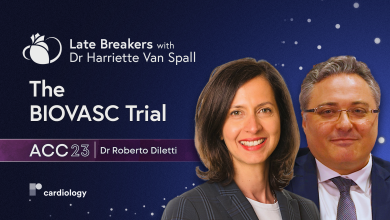Search results
Author(s):
Barbara Stähli
Added:
7 months ago
ESC 2023 — Prof Barbara Stähli (University Hospital Zurich, CH) joins us onsite at ESC 23 to outline the findings of the MULTISTARS AMI Trial (NCT03135275).
MULTISTARS AMI aimed to compare the safety and efficacy of two treatment strategies currently performed in clinical practice, immediate complete revascularization versus staged complete revascularization in patients presenting with ST…
View more
Author(s):
Harriette Van Spall
,
Roberto Diletti
Added:
1 year ago
ACC.23/WCC –Late-Breaker host, DrHarriette Van Spall(McMaster University, CA) is joined by principal investigator, DrRoberto Diletti(Thoraxcenter, Erasmus Medical Center, NL) to explore the findings of theBIOVASC Trial (NCT03621501).
The primary objective of the BIOVASC Trial was to investigate whether an immediate complete revascularization is non inferior to a staged complete…
View more
Author(s):
Emmanuel Ako
,
Sukhjinder Nijjer
,
Abtehale Al-Hussaini
,
et al
Added:
2 years ago
Author(s):
Roxy Senior
Added:
3 years ago
Introduction
In the UK there is still an emphasis on coronary anatomy as currently assessed using coronary angiography; however, high-grade coronary lesion may not cause myocardial ischaemia, for example in the presence of extensive collateral vessels. Dynamic imaging to show the physiological effect of any coronary stenosis is therefore an important part of the investigation of patients with…
View more
Author(s):
Roxy Senior
Added:
3 years ago
Introduction
In the UK there is still an emphasis on coronary anatomy as currently assessed using coronary angiography; however, high-grade coronary lesion may not cause myocardial ischaemia, for example in the presence of extensive collateral vessels. Dynamic imaging to show the physiological effect of any coronary stenosis is therefore an important part of the investigation of patients with…
View more
Author(s):
William Fearon
Added:
2 years ago
In this short interview, Dr William F Fearon (Stanford University School of Medicine, US) discusses the findings from the FAME3 trial. This multicenter, international, randomized, controlled noninferiority trial investigated whether fractional flow reserve (FFR)-guided percutaneous coronary intervention (PCI) in patients with multivessel coronary artery disease (CAD) will result in similar…
View more
Author(s):
Maria Chiara Scali
,
Doralisa Morrone
,
Mario Marzilli
Added:
3 years ago
As coronary angiography is of limited value in defining the functional significance of a stenosis, the timely article by Balanescu in this issue of European Cardiology Review rationally proposes to integrate the anatomic information with a functional assessment, either by measuring coronary flow reserve (CFR) or intracoronary artery pressure with fractional flow reserve (FFR). CFR measurements…
View more
Author(s):
Serban Balanescu
Added:
3 years ago
Coronary artery disease (CAD) due to atherosclerosis is a major cause of morbidity and mortality. Early prevention of atherothrombotic disease with a healthy lifestyle (diet, exercise, optimal body weight and no smoking) is considered the best method of “treating” CAD, although increasing age remains associated with significant cardiovascular events.
When coronary atherothrombotic disease…
View more
Author(s):
Alda Huqi
,
Giacinta Guarini
,
Doralisa Morrone
,
et al
Added:
3 years ago
Myocardial revascularisation in patients with stable chronic angina is performed with the aim of reducing cardiovascular death, reducing myocardial infarction (MI) and relieving angina symptoms. However, contrary to expectations, modern therapy with percutaneous coronary intervention (PCI) has not had a significant impact on hard outcomes.1–5 Indeed, as also summarised in a recently published…
View more
Author(s):
Gabriel Torres-Ruiz
,
Nuria Mallofré-Vila
,
Paola Rojas-Flores
,
et al
Added:
4 months ago














